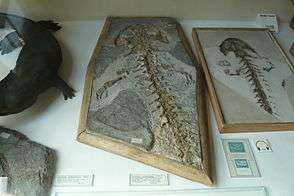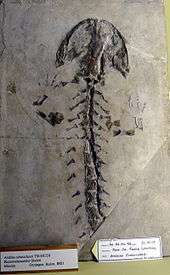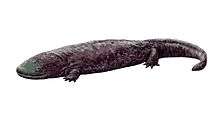Andrias scheuchzeri
Andrias scheuchzeri is an extinct species of giant salamander, which is only known from fossils. It lived from the Oligocene to the Pliocene.[1] It and the extant A. davidianus cannot be mutually diagnosed, and the latter, only described in 1871, is therefore sometimes considered a synonym of the former.[2]
| Andrias scheuchzeri | |
|---|---|
 | |
| Holotype (in middle) at Teylers Museum, Scheuchzer's Homo diluvii testis | |
| Scientific classification | |
| Kingdom: | Animalia |
| Phylum: | Chordata |
| Class: | Amphibia |
| Order: | Urodela |
| Family: | Cryptobranchidae |
| Genus: | Andrias |
| Species: | †A. scheuchzeri |
| Binomial name | |
| †Andrias scheuchzeri (Holl, 1831) | |
| Synonyms | |
| |
History

In his book Lithographia Helvetica from 1726, Johann Jakob Scheuchzer described a Miocene fossil found in Öhningen as Homo diluvii testis (Latin: Man, witness of the Deluge), believing it to be the remains of a human that drowned in the biblical Deluge. The fossil was about 1 m (3 ft) long, lacked its tail and hind legs, and could thus be interpreted as showing some resemblance to the remains of a violently trampled human child.
In 1758, the first to doubt his theory in print was Johannes Gessner, who thought it was a giant catfish (Siluris). In 1787 Petrus Camper thought it was a lizard (Lacerta); at that time, scholars and the scientific community generally did not differentiate between reptiles and amphibians. In 1802 Martin van Marum bought this fossil for Teyler's Museum in Haarlem from Scheuchzer's grandson in Zürich, along with a fossilized swordfish, for 14 Louis d'or.[3] It can still be seen in Teyler's Museum, in the original showcase.
Seven years later, the fossil again came under scrutiny when the famous Georges Cuvier published an article in which he claimed the fossil was "nothing but a salamander, or rather a proteus of gigantic dimensions and of an unknown species".[4] He proceeded to examine the fossil in Haarlem, by then a part of the French Empire, in 1811. After hacking away gently at the fossil, he uncovered the foremost limbs and the specimen was recognized as a giant salamander.[5] The difference in color of the stone shows what Scheuchzer saw and what Cuvier later could see.
The specimen was renamed Salamandra scheuchzeri by Friedrich Holl in 1831. The genus Andrias was only coined six years later by Johann Jakob von Tschudi.[6] In doing so, both the genus, Andrias (which means image of man), and the specific name, scheuchzeri, ended up honouring Scheuchzer and his beliefs. The Teylers Museum has several other specimens in their collection in addition to this one.
In fiction

The fictional descendants of Andrias scheuchzeri are the primary antagonists in Karel Čapek's 1936 science fiction novel War with the Newts.
Sources
- http://www.wahre-staerke.com/~madelaine/EGU2010_Andrias.pdf
- Amphibian Species of the World 5.1. Genus Andrias. Accessed 2008-04-10.
- Wim de Jong (1988), "De zondvloedmens. Een mens werd salamander. Over Andrias scheuchzeri", Teylers Museum Magazijn 6(4), 7-10.
- Georges Cuvier (1809), "Sur quelques quadrupèdes ovipares fossiles conserves dans des schistes calcaires", Annales du Muséum naturelle 13, 397-437.
- L. Touret & A. van der Werf (1984), "De betrekkingen van Georges Cuvier met Teylers Museum.", Teylers Museum Magazijn 2(1), 7-10.
- Jakob von Tschudi, (1837), "Über den Homo diluvii testis, Andrias Scheuchzeri", Neues Jahrbuch für Mineralogie, Geognosie, Geologie und Petrefaktenkunde
Bibliography
- Richard Ellis (2001), Aquagenesis: The Origin and Evolution of Life in the Sea (London: Penguin).
- Robert Hofrichter (2000), Amphibians: The World of Frogs, Toads, Salamanders and Newts (Toronto: Key Porter Books)
- J. Alan Holman (2006), Fossil Salamanders of North America (Life of the Past) (Bloomington: Indiana University Press)
- J. William Schopf (2001), Cradle of Life: The Discovery of Earth's Earliest Fossils (Princeton: Princeton University Press)